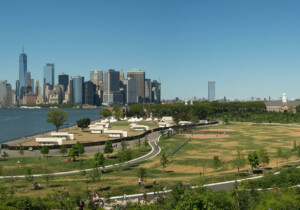For Enclos‘ Alex Barmas, true innovation in facade design and fabrication is about more than the latest technological bells and whistles. Rather, it is about exercising creativity despite the restrictions posed by tight budgets, compressed timelines, and aggressive real estate markets.
At Facades+ NYC later this month, Barmas will moderate a conversation on implementing innovation with AEC industry leaders including Cutler Anderson Architects‘ Jim Cutler, Arup‘s Tali Mejicovsky, Michael Stein, of Schlaich Bergermann & Partner, and Richard Meier & Partners‘ Vivian Lee. “My intention is to get the panelists talking about the possibilities of producing truly fantastic architecture while constrained by very real-world budgets and schedules,” said Barmas. “They have all worked on projects where an intelligent and responsive approach to design, and an intelligence about materials and tectonics have allowed them to deliver great projects under tight constraints. The panel will focus on the commitment and perseverance required to execute and deliver such projects.”
New York is a hotbed of facade innovation exactly because of the particular constraints at play there, said Barmas. In much of the United States, he explained, the litigious nature of the building design and construction market tends to discourage integrated project deliver. But “the New York market is actually a counterbalance to this. Due to the complexity of building projects, compressed construction schedules, and the need for coordination throughout the design and construction process, projects must take on a more holistic design mentality.” At the same time, said Barmas, the drive to build taller and faster for the top of the market “has meant that there are some very interesting building envelopes either recently built, or under construction.” As a case in point, he cited BIG‘s 625 West 57th Street (W57), calling it “a fantastic example of a really interesting curtain wall.”
All of this is not to say that new technology is not compelling—especially when made a part of built projects. “I’m very excited about the continuing integration of sensors, actuators, and other electrical components with the building envelope to create active and responsive facades,” said Barmas. “This seems to be turning into a virtuous cycle where integrated systems are becoming more robust, system integration is improving, and all the parties to a building project are becoming more comfortable implementing these systems. System intelligence and integration enable us to achieve better performance with traditional building envelope components.”
To hear more from Barmas and panelists on bringing facades innovations to fruition, register today for Facades+ NYC. More information, including a complete symposium agenda, is available online.










